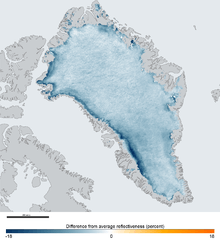Arctic Report Card
The National Oceanic and Atmospheric Administration's Arctic Report Card[1] presents annually updated, peer-reviewed information on recent observations of environmental conditions in the Arctic relative to historical records. The annual updates are released during a press conference at the December American Geophysical Society meeting. This annual report which measures the changes in climate can be used to predict the driving shifts in animal habitats and the local arctic ecosystem.[2] The report categorised into three groups: Vital signs, Other Indicators and Frostbite.[3]

Key highlights are featured on the current report card home page, previous report cards are available online, and each report card is summarized in a short YouTube video.
The audience for the Arctic Report Card is wide, including scientists, students, teachers, decision makers and the general public interested in Arctic environment and science.
Indicators
The Arctic report card is categorised into three sections: Vital signs, other indicators and frostbite
The seven areas under ‘Vital signs ‘ ,which are annually updated:
• Surface Air Temperature
• Terrestrial Snow Cover
• Greenland Ice Sheet
• Sea Ice
• Sea Surface Temperature
• Arctic Ocean Primary Productivity
• Tundra Greenness
Frostbites reports on new and emerging issues, and topics that relate to long-term scientific observations in the Arctic.
Other Indicators explores topics that are updated periodically. [4]
2019
The Arctic Report Card for 2019 has contributions from 81 researchers spread over 12 countries. For the first time, this year's report contains an essay by Indigenous Peoples from the Bering Sea region. A YouTube video summarizes the annual highlights.
The major findings were:
• The second warmest surface air temperature since 1900.
• The area of Arctic sea ice in summer 2019 was markedly reduced. It was reported the second lowest since satellite observations began in 1979. This has caused migration of Arctic fish to more northern waters.
• The highest recorded ice loss from Greenland Ice Sheet.
• Early snowmelt in Arctic of northwestern Canada and Alaska in March.Fifth lowest and third lowest North American Arctic snow cover in the month of May and June 2019 respectively.[5]
2018
The 2018 Arctic Report Card has contributions from 81 scientists, working for governments and academia, from 12 countries. A YouTube video summarizes the annual highlights.[6]
2017
The Arctic Report Card for 2017 has contributions from 85 authors spread over 12 countries. The 2017 report contains 12 essays, separated into three sections: Vital Signs, Other Indicators, and Frostbites. A YouTube video summarizes highlights for this Report Card.
2016
The 2016 Arctic Report Card reflects the combined efforts of 61 authors from 11 countries. The 12 essays were subject to independent peer-review organized by the Arctic Monitoring and Assessment Programme (AMAP) of the Arctic Council.
In 2016, continuation of long term warming trends and sea ice loss are triggering extensive Arctic Changes. Key highlights are featured on the Home Page, which includes a YouTube video that summarizes the Report Card.
2015
The Arctic Report Card reflected the combined efforts of 72 authors from 11 countries. The 12 essays were subject to independent peer-review organized by the Arctic Monitoring and Assessment Programme (AMAP) of the Arctic Council.
The 2015 Report Card essays are organized into 3 sections: Vital Signs; Indicators; and Frostbites. Key highlights are featured on the Home Page, which includes a YouTube video that summarizes the Report Card.
In 2015, Arctic sea extent at the end of the winter was the lowest during the satellite record and the winter maximum occurred 15 days earlier than in the past. The sea ice minimum at the end of summer was the 4th lowest extent on record. These changes are having profound impacts in both the marine and terrestrial ecosystems and in sea surface temperatures.
References
- National Oceanic and Atmospheric Administration (NOAA)'s annually issued Arctic Report Card.
- "2018 Arctic Report Card: Visual highlights | NOAA Climate.gov". www.climate.gov. Retrieved 2020-02-09.
- "Arctic Report Card: Record territory for warm temperatures, loss of snow and ice | National Oceanic and Atmospheric Administration". www.noaa.gov. Retrieved 2020-02-29.
- "Arctic Report Card: Record territory for warm temperatures, loss of snow and ice | National Oceanic and Atmospheric Administration". www.noaa.gov. Retrieved 2020-02-09.
- "2019 Arctic Report Card: Visual highlights | EarthSky.org". earthsky.org. Retrieved 2020-02-29.
- "Warming, sea-ice loss: Arctic Report Card tracks region's environmental changes: Annual update improves understanding of changing climate, wildlife impacts". ScienceDaily. Retrieved 2020-02-09.